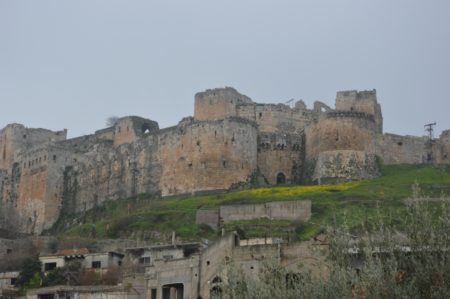Near historical landmark, Christian community in SYria slowly returns
QALAT’AL HOSN is a village in western Syria in a region known as the Valley of the Christians. The locale is best known for the imposing castle called the Crak des Chevaliers. This crusader castle is one of the most important preserved medieval castles in the world. It is a World Heritage Site, one of the historic jewels of Syria, which before the country’s war attracted tourists from all over the world.

“A group of Salafists and Muslim extremists arrived here, many of them from Lebanon, crossing over the border, which is only about 20 miles away. They seized control of the fortress and the village,” explained Father George Maamary, parish priest of the local Melkite community of the Church of the Assumption.
He said: “As soon as they arrived, they came to the church where I was living, forced their way in and abducted me. They beat me up, so that afterwards I had to have an operation on my shoulder. Thanks be to God, my imprisonment did not last long; they exchanged me for a jihadist fighter who had been captured by the government.”
At the time of the raid, the village had around 25,000 inhabitants of various different religions, most of them Sunni and Shia Muslims. There were also some 300 Christians, living around the only Christian church, that of Our Lady of the Assumption.
As soon as news of the abduction of Father Maamary spread, neighbours, all the Christians abandoned their homes for fear of suffering the same fate. “It was a warning. Since then not one Christian family has returned to live here,” the priest said. That was six years ago.
The fortress was damaged by the rebel groups and by the fighting to recover it, along with a considerable part of the village itself. In 2014 the castle and the village were reconquered by the Syrian army. This was the only place in the Valley of the Christians where there has been fighting. For the rest of the country, this area has become a place where many refugees live, since it is one of the more peaceful parts of the country
The rebels did much looting, and among the places that were looted were the church and the homes of the Christians. “The life of the community used to revolve around the church,” Father George explains, adding: “We had a basketball pitch and rooms for catechesis and other gatherings. You can see how everything is now,” he said, pointing at destroyed structures.
The church was part of a complex of various other buildings, and there was formerly a hotel named after John Paul II, which catered to tourists visiting the fortress. There had been up to 17 shops, a restaurant, a café, and a number of souvenir and gift shops.
After the defeat of the Sunni rebels, government troops—who are pro-Shiite—took vengeance on local Sunnis. Father George had to hasten back and mark the houses of the Christians with black crosses, so that the soldiers would not burn them along with the Sunni-owned homes.
“Before the fighting, the relationship between Christians and Muslims was good,” said Father George, suggesting that the war left a terrible wound that will take years to heal. “It is safe again now in this region, but there is still no electricity or water,” he added. As a result, the Christians have been unable to return, despite the fact that the village was liberated all of four years ago. “The sense of helplessness of these families is very great; they are still uprooted and living in other villages of the Valley of the Christians, such as Marmarita and Kafra, only six miles away from here, and yet they still cannot return.”
Around the church of the Assumption there are a few houses that people have begun to rebuild. One of them belongs to the family of Bassam Maamary, a cousin of Father George and himself a priest. “I have begun to rebuild the house with my own money, in order to show my neighbors that it is possible to return, that there is still hope,” he said.

He is being helped with the electric wiring by a young man named Wagdi Yazzi. He too is from the village of Al Hosn. “It won’t take much for us to return; but first we need the government to reconnect the water and electricity”, he said, adding: “Life here was very pleasant and peaceful. We had contact with people from all over the world and we were a very open village.”
Another neighbor appears, Samir Bashur, who is also working on his house. He insists that if people are to return to the village permanently, they will first have to rebuild the church. “It is a place that is very important to us, where we celebrate the most important feasts together, where we meet and pray together, along with our parish priest.”
Father George made it clear that he has not lost contact with the other families. “We are doing the impossible to help them on a daily basis, so that they will eventually will be able to return to their homes.”
—Josué Villalón

